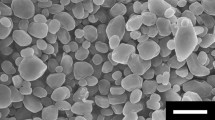Abstract
A typical copper-copper thermocompression bonding process is carried out in an ultrahigh vacuum (UHV) or inert environment at a bonding temperature >300°C. The ultraclean environment serves a single purpose – to maintain oxide-free copper surfaces, allowing intimate physical contact between copper atoms. This study investigates the temperature dependence of direct copper bonding from room temperature to 300°C under ambient condition. An anomalous thermal dependence of bond strength occurs between 80°C to 140°C where an increase in bonding temperature within this regime is in fact, detrimental to joint strength. This is interpreted as a thermal competition between oxidation and bond formation. This study also demonstrates that by simply coating the copper surface with a self assembled monolayer of 1-undecanethiol prior to bonding, Cu joints can be successfully formed at close to ambient temperature without a vacuum, yielding joint shear strengths on the order of 70MPa. The densely packed monolayer serves to passivate the copper surface against oxidation under ambient conditions. The ultrathin organic monolayer structure, as compared to a bulk oxide layer, could be easily displaced during the mechanical deformation at the bonding interface which accompanies thermocompression. This method could be an effective simple bonding solution for three-dimensional integrated chips.
Similar content being viewed by others
References
K. Buchanan, “The evolution of interconnect technology for silicon integrated circuitry.,” in The International Conference on Compound Semiconductor Manufacturing Technology (GaAsMANTECH), 2002.
R. Liu, C.-S. Pai, and E. Martinez,” Solid-State Electronics, 43, 1003–1009, (1999).
K. Banerjee, S. J. Souri, P. Kapur, and K. C. Saraswat,” Proceedings of the IEEE, 89, 602–633, (2001).
K. N. Chen, C. S. Tan, A. Fan, and R. Reif,” Electrochem. Solid-State Lett., 7, G14, (2004).
K. N. Chen, A. Fan, C. S. T. and, and R. Reif,” J. Electron Mat, 32, 1371 -1374, (2003).
T. Branschwiler and B. Michel, “Thermal Management of Vertically Integrated Packages,” in Handbook of 3D Integration:Technology and Applications of 3D Integrated Circuits vol. 2, P. Garrou, C. Bower, and P. Ramm, Eds.: WILEY-VCH Verlag GmbH & Co., (2008).
K. N. Chen, S. M. Chang, L. C. Shen, and R. Reif,” J. Electron Mat, 35, 1082–1086, (2006).
K. N. Chen, A. Fan, C. S. Tan, and R. Reif,” J. Electron Mat, 35, 230, (2006).
CS. Tan, K.N. Chen, A. Fan, and R. Reif,” J. Electron Mat, 34, 1598, (2005).
K. N. Chen, C. S. Tan, A. Fan, and R. Reif,” Electrochem. Solid-State Lett., 7, G14–G16, (2004).
A. Fan, A. Rahman, and R. Reif,” Electrochem. Solid-State Lett., 2, 534–536, (1999).
K. N. Chen, A. Fan, and R. Reif,” J. Electron Mat, 30, 331, (2001).
K. N. Chen, A. Fan, and R. Reif,” J. Mat. Sci, 37, 3441, (2002).
P. E. L. a. G. M. Whitesides,” J. Am. Chem. Soc, 114, 9022–9028, (1992).
K. N. Chen, “Copper Wafer Bonding In Three-Dimensional Integration,” in Electrical Engineering and Computer Science, vol. Doctor of Philosophy Boston, MA: Massachusetts Institute of Technology, 2005.
K. N. Chen, C. S. Tan, A. Fan, and R. Reif,” J. Electron Mat, 34, 1464 - 1467, (2005).
T. H. Youssef and R. A. Essawi,” Czech. J. Phys, 29, 1266, (1979).
D. L. Cocke, R. Schennach, M. A. Hossain, D. E. Mencer, H. McWhinney, J. R. Parga, M. Kesmez, J. A. G. Gomes, and M. Y. A. Mollah,” Vacuum, 79, 71–83, (2005).
H. Derin and K. Kantarli,” App. Phys. A, 75, 391, (2002).
H. Wieder and A. W. Czanderna,” J. Appl. Phys, 37, 184–187, (1966).
Y. Yamamoto, H. Nishihara, and K. Aramaki,” J Electrochem Soc, 140, 436–443, (1993).
G. K. Jennings and P. E. Laibinis,” Colloids Surf., A, 116, 105–114, (1996).
Y. Q. Feng, W. K. Teo, K. S. Siow, Z. Q. Gao, K. L. Tan, and A. K. Hsieh,” J Electrochem Soc, 144, 55–64, (1997).
A. Krishnamoorthy, K. Chanda, S. P. Murarka, G. Ramanath, and J. G. Ryan,” Appl. Phys. Lett, 78, 2467–2469, (2001).
N. Mikami, N. Hata, T. Kikkawa, and H. Machida,” Appl. Phys. Lett, 83, 5181–5183, (2003).
Y. S. Tan, M. P. Srinivasan, S. O. Pehkonen, and Y. M. C. Simon,” J. Vac. Sei. Technol., A, 22, 1917–1925, (2004).
F. Zucchi, V. Grassi, A. Frignani, and G. Trabanelli,” Corros. Sci., 46, 2853–2865, (2004).
D. A. Hutt and C. Liu,” Appl. Surf Sci., 252, 400–411, (2005).
K. N. Chen, A. Fan, and R. Reif,” J. Mat. Sci, 37, 3441–3446, (2002).
X. F. Ang, F. Y. Li, J. Wei, W. L. Tan, and C. C. Wong,” Thin Solid Films, 516, 5721–5724, (2008).
X. F. Ang, Z. Chen, C. C. Wong, and J. Wei,” Appl. Phys. Lett, 92, 131913, (2008).
X. F. Ang, F. Y. Li, W. L. Tan, Z. Chen, C. C. Wong, and J. Wei, “Low Temperature Direct Metal Bonding by Self Assembled Monolayers,” in Materials Research Society Symposium Proceedings, vol. 990 San Francisco, US, 2007, pp. 0990-B10-03.
P. E. Laibinis, G. M. Whitesides, D. L. Allara, Y. T. Tao, A. N. Parikh, and R. G. Nuzzo,” J. Am. Chem. Soc, 113, 7152–7167, (1991).
H. L. Leong, C. L. Gan, C. V. Thompson, K. L. Pey, and H. Y. Li,” J. Appl. Phys, 102, 103510, (2007).
H. L. Leong, C. L. Gan, C. V. Thompson, K. L. Pey, and H. Y. Li, “Effects of Nanometer-Scale Surface Roughness and Applied Load on the Bond Strength and Contact Resistance of Cu-Cu Bonded 3D ICs,” in Materials Research Society: Symposium Proceedings, Boston, MA, 2007, pp. 1036-M02-05.
Author information
Authors and Affiliations
Rights and permissions
About this article
Cite this article
Ang, X.F., Wei, J., Chen, Z. et al. Ambient Copper-Copper Thermocompression Bonding using Self Assembled Monolayers. MRS Online Proceedings Library 1112, 203 (2008). https://doi.org/10.1557/PROC-1112-E02-03
Received:
Accepted:
Published:
DOI: https://doi.org/10.1557/PROC-1112-E02-03




